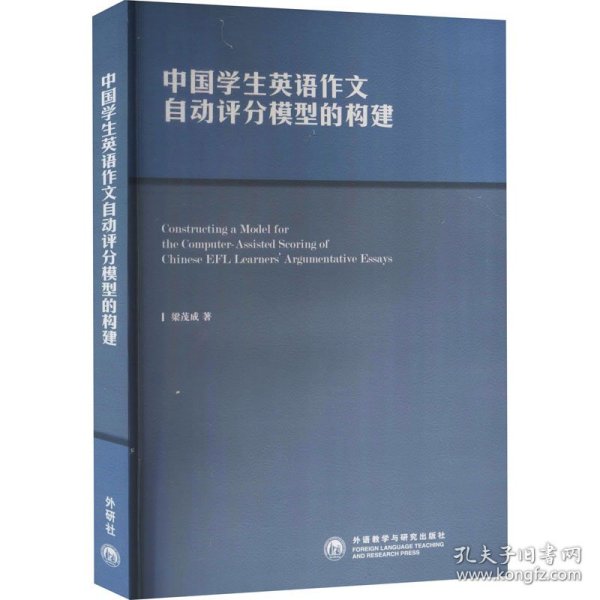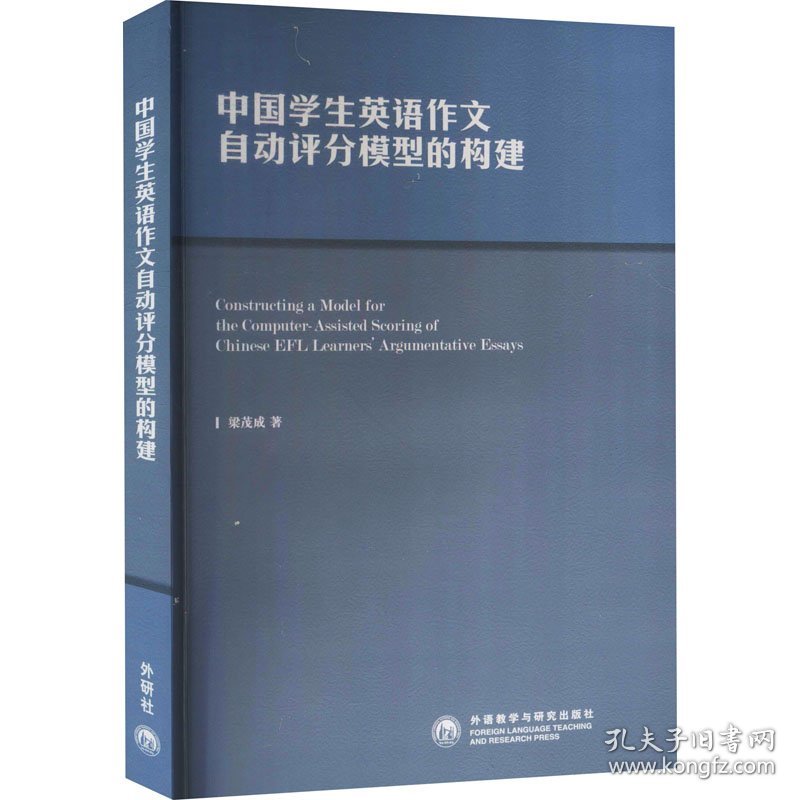全新正版 可开发票 极速发货
-
出版时间:
2011-01
-
装帧:
平装
-
开本:
16开
-
ISBN:
9787513504997
-
出版时间:
2011-01
售价
¥
34.76
5.0折
定价
¥69.90
品相
全新
上书时间2024-04-12
卖家超过10天未登录
手机购买
![]()
微信扫码访问
-
-
商品描述:
-
目录
List of Abbreviations
List of Tables
List of Figures
Part One Introduction
Introducing the Study
0.1 Introductory remarks
0.2 Need for this study
0.2.1 Theoretical considerations
0.2.2 Practical considerations
0.3 Description of the study
0.4 Organization of the study
0.5 Summary
Part Two Literature Review
Chapter 1 A Review of Existing Computer-Assisted Essay Scoring Systems
1.1 Introduction
1.2 Key concepts
1.2.1 Computer-assisted essay scoring
1.2.2 EFL writing assessment
1.3 Existing computer-assisted essay scoring systems
1.3.1 Project Essay Grade (PEG): A form-focused system
1.3.2 Intelligent Essay Assessor (IEA): A content-focused system
1.3.3 E-rater: A hybrid system with a modular structure
1.3.4 An appraisal of the three existing systems
1.4 Lessons from existing essay scoring systems
1.5 Summary
Chapter 2 Studies on Measures of Writing Quality
2.1 Introduction
2.2 Measures of writing quality in the literature
2.2.1 Measures of the quality of language
2.2.2 Measures of the quality of content and organization
2.3 An overview of the measures in the literature
2.4 A conceptual model for the computer-assisted scoring of EFL essays
2.5 Proposed measures of EFL writing quality
2.5.1 Proposed measures of the quality of language in EFL writing
2.5.2 Proposed measures of the quality of content in EFL writing
2.5.3 Proposed measures of the quality of organization in EFL writing
2.6 Summary
Part Three Methodology
Chapter 3 Research Questions and Data Preparation
3.1 Introduction
3.2 Research questions
3.3 The corpus
3.4 The rating scheme
3.4.1 Selecting a rating scale
3.4.2 The revised rating scale
3.4.3 The evaluation of content
3.4.4 The weighting scheme
3.5 Rating
3.5.1 Rater selection
3.5.2 Rater training
3.5.3 The rating sessions
3.6 Score reliability
3.7 Summary
Chapter 4 Text Analysis and Statistical Analysis
4.1 Introduction
4.2 Tools
4.3 Essay feature extraction
4.3.1 Language features
4.3.2 Content features
4.3.3 Organizational features
4.4 Data analysis
4.4.1 Correlation analysis
4.4.2 Multiple regression analysis
4.4.3 Stages of data analysis
4.5 Summary
Part Four Results and Discussion
Chapter 5 Identifying Predictors of EFL Writing Quality
5.1 Introduction
5.2 Linguistic features and writing quality
5.2.1 Fluency and writing quality
5.2.2 Complexity of language and writing quality
5.2.3 Measures of linguistic idiomaticity and appropriateness
5.3 Results of content analysis
5.3.1 Results of Latent Semantic Analysis
5.3.2 Procedural vocabulary and essay score
5.4 Essay organization and writing quality
5.4.1 Paragraphing and writing quality
5.4.2 Discourse conjuncts and writing quality
5.4.3 Demonstratives, pronouns, connective and writing quality
5.5 Power of the predictors proposed in this study
5.6 Summary
Chapter 6 A Statistical Model for Computer-Assisted Essay Scoring
6.1 Introduction
6.2 Diagnosing the preliminary model
6.3 The refined model
6.4 Predictors and aspects of writing quality measured
6.4.1 Predictors in the language module
6.4.2 Predictors in the content module
6.4.3 Predictors inthe organization module
6.4.4 Interdependence of the modules
6.5 Implementing the model
6.6 Summary
Chapter 7 Validating the Model
7.1 Introduction
7.2 Cross-validating the model
7.3 Reliability of computer scores in cross-validation
7.3.1 Aspects of reliability
7.3.2 Consistency estimates
7.3.3 Consensus estimates
7.4 Double cross-validation
7.4.1 Constructing the model
7.4.2 Model statistics and estimated equation
7.5 Reliability of computer scores in double cross-validation
7.6 Comparison with existing essay scoring systems
7.6.1 Comparison with PEG
7.6.2 Comparison with IEA
7.6.3 Comparison with E-rater
7.7 Summary
Part Five Conclusion
Chapter 8 Conclusion
8.1 Major findings
8.1.1 A model for the computer-assisted scoring of EFL essays
8.1.2 Predictors of EFL writing quality
8.2 Limitations of the study
8.3 Future work
References
Appendices
Appendix Ⅰ PEGs proxes and their beta values (Page 1968)
Appendix Ⅱ Pages (1995) model and variables
Appendix Ⅲ Argument weight
Appendix Ⅳ Examples of good openings and endings
Appendix Ⅴ Scoring table (Organization & Content)
Appendix Ⅵ Scoring table (Language)
Appendix Ⅶ List of stopwords
Appendix Ⅷ Lemma list (excerpt)
Appendix Ⅸ List of content words
Appendix Ⅹ Sample essays
Appendix Ⅺ POS-tagged samples
内容摘要
《中国学生英语作文自动评分模型的构建》旨在构建中国学生英语作文自动评分的统计模型,探讨学生英语作文中的多种文本特征项对学生作文成绩的预测能力。通过模型构建和模型验证表明机器评分的信度达到甚至超过人工评分的信度,该模型对中国学生英语作文质量的解释能力可以与国外应用于母语作文自动评分的软件系统对母语作文质量的解释能力相媲美。

![]()
孔网啦啦啦啦啦纺织女工火锅店第三课
开播时间:09月02日 10:30
即将开播,去预约


直播中,去观看

 占位居中
占位居中





 直播中,去观看
直播中,去观看